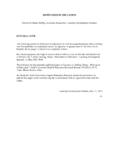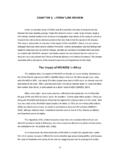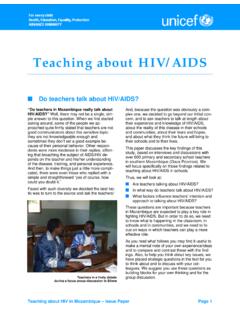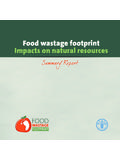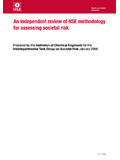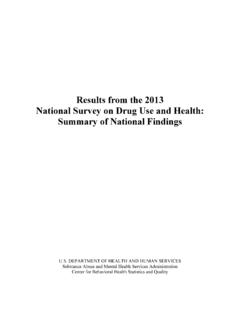Transcription of Summary of the Study Problem and Methodology
1 130 CHAPTER 5: DISCUSSION As an aide to the reader the final chapter of this dissertation provides a brief overview of the Study , including a statement of the Problem and the major methods involved. The majority of the chapter is, however, devoted to a Summary and discussion of the six Study hypotheses and to a discussion of the pertinence of the results for the role of teachers in HIV/AIDS awareness and prevention. Summary of the Study Problem and Methodology HIV/AIDS has spread hard and fast in Africa over the past two decades, over seventy percent of all new HIV infections take place in Africa (UNAIDS, 2003). Sub-Saharan Africa has been especially affected, where several countries, such as Botswana, Malawi and Swaziland, have reached adult prevalence rates of 20% and over.
2 As the disease is increasingly impacting on the social, economic, cultural and even political fabric of these countries, urgent efforts are being made to mobilize all possible resources human, economic, and otherwise to halt the spread of the disease (IBRD/World Bank, 2000). One of the resources that is increasingly being mobilized in the fight against HIV/AIDS are teachers. The assumption is that teachers are ideally situated to reach children as well as young people, and to play an important role in providing key information, in teaching essential skills and in contributing to attitude change that will allow these children to protect themselves.
3 Children between 5 and 14 are considered the window of hope (IBRD/World Bank, 2002) in fighting the disease because they have escaped infection at birth, are assumed not yet to be sexually active, and are still in the process of developing attitudes and behavioral patterns and are therefore more easily influenced than adults (UNAIDS, 1997). In spite of this important role of teachers, however, the bulk of the research on HIV/AIDS and education has focused on students and young people rather than on teachers themselves. Only very few studies have examined the current and potential role of teachers in the context of HIV/AIDS ( Lin & Wilson, 1998; Action Aid, 2003).
4 And, in general there appears to be an implicit assumption on the part of policy makers and practitioners in education that provided teachers are given the right conditions, they will - regardless of their individual characteristics - ensure that students know what they need to know in order to effectively protect themselves. 131 The overall purpose of this Study was to identify and further understand key factors that may contribute to teachers willingness to communicate about HIV/AIDS in the educational setting. In this manner, the Study sought to fill the gap in the research on teachers and HIV/AIDS which has typically focused on cataloguing teachers knowledge and attitudes, but without relating them directly to practice.
5 The assumption of this Study was that a better understanding of the personal and contextual variables that influence teachers willingness to communicate about HIV/AIDS could provide a key input into policy decisions and into the design of practical interventions that will strengthen the teacher s role as communicators about HIV/AIDS. Acknowledging that the integration of models and theories in studies of this nature in developing settings is generally lacking (Kelly, 1999), two theoretical frameworks, the Theory of Planned Behavior, and Attitude Function Theory were used as basis for the inquiry into these individual difference variables. Other important variables which could impact on past and future behavior of teachers were identified and operationalized in the course of the Study itself based on an extensive review of the available literature as well as on the focus group discussions with teachers in the pilot phase of the Study .
6 In this manner the following variables were identified as possible predictors of teachers willingness to communicate about HIV/AIDS: age, sex, knowledge of HIV/AIDS, personal experience with HIV/AIDS, condom use, perceived personal risk, attitudes toward talking about HIV/AIDS, social norms, perceived behavioral control, and attitude functions. Previous studies have typically examined HIV/AIDS teaching from the perspective of behavioral intent only. However, discussions with teachers during the pilot phase of the Study had indicated that talking about HIV/AIDS was context specific and could involve either future behavior or past behavior of a combination of both.
7 This Study thus departed from the approach taken by other studies by operationalizing the predicted behavior willingness to communicate about HIV/AIDS in terms of three types of behavior: future intentions to talk about HIV/AIDS with students, past behavior of talking about this topic in school, and past community behavior. This Study was conducted in the province of Gaza in Southern Mozambique among primary and secondary school teachers. A non-experimental mainly quantitative, research design was used to examine the individual difference variables that were identified as being potentially important to teachers willingness to communicate about HIV/AIDS.
8 Data were obtained by administering surveys containing predominantly structured questions to teachers in five districts of Gaza province. Although the Study was mainly quantitative in nature, qualitative techniques were used to: inform the Study during the design phase; to aid conceptual and instrument development; and to assist in the interpretation and clarification of the results of the Study . 132 The Study was conducted in two phases. The first - pilot - phase took place over a period of seven weeks in the months of June and July, 2003. During the pilot phase, key issues impacting on teachers willingness to communicate about HIV/AIDS were identified and instruments developed, adapted and tested to measure these variables.
9 The second phase took place in September 2003, and covered a three-week period during which questionnaires were administered to a stratified sample of 606 primary and secondary school teachers as well as to a convenience sample of 157 primary and secondary school students in five districts of the province. In addition, individual in-depth interviews were conducted with 28 teachers. In the next section the main conclusions for each of the six hypotheses of the Study are reviewed. In addition, implications for further research are discussed. Review and Discussion of the Main Conclusions of the Study Six hypotheses were formulated for this Study .
10 For all six hypotheses the predicted measures were: a) future intentions to talk about HIV/AIDS in the coming month; b) past school behavior (also measured over a one-month period); and c) past community behavior by teachers. In this Study these three behaviors are grouped together under the heading willingness to communicate about HIV/AIDS . Each of the three behavior types was analyzed from two perspectives. The first perspective - referred to as the 2 level comparison - contrasted no behavior (future, in school, in community) with any level of behavior in these settings. The second perspective acknowledged the existence of different degrees/levels of behavior by contrasting no behavior, with limited behavior and high consistent behavior.
